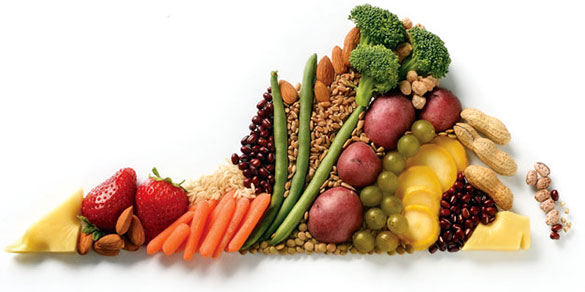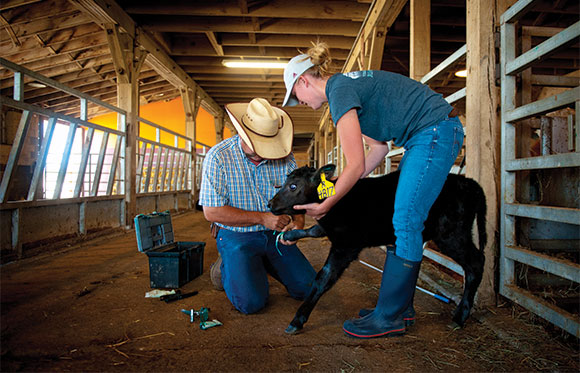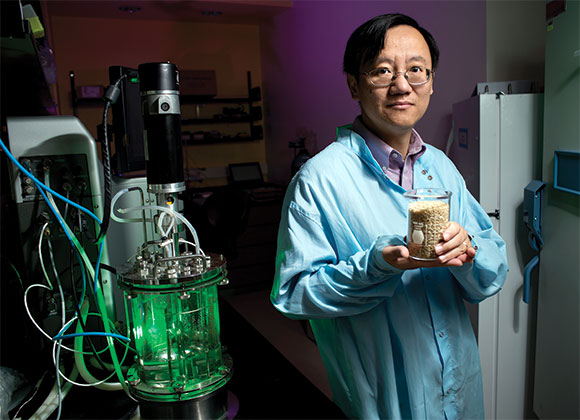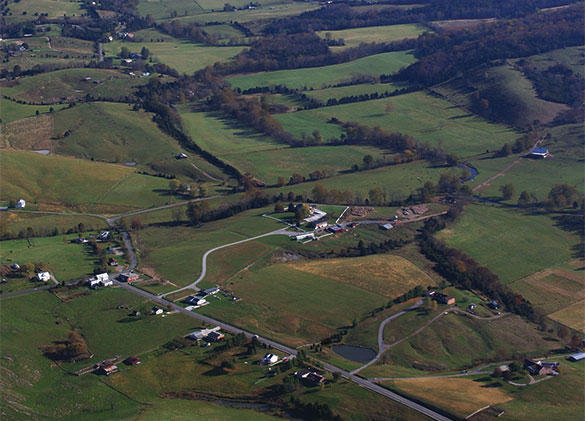FEATURE

A 2013 United Nations report projects that the world population will reach 9.6 billion by 2050. More food must be grown in a shrinking amount of space, and more water will be needed for drinking, agriculture, manufacturing, and more. That's where we come in.
A cow quietly lowed from the back of the barn as Chad Joines described the process of artificially inseminating a heifer to about 40 Virginia cattlemen and cattlewomen.
The group, ranging from youngsters who looked fresh out of high school to longtime farmers in their 70s, listened closely as Joines, an agricultural supervisor in the College of Agriculture and Life Sciences' (CALS) Department of Animal and Poultry Sciences, ran through the basics of hormones, pregnancy, and managing a large herd of cows going into heat at roughly the same time.
A few minutes later, the group gathered around a monitor as Joines used ultrasound to determine the gender of an unborn calf.
"All that black in there is the baby," Joines said. "See that snake right there coming into the body of the calf? That would be the umbilical cord."
He talked the group through calf anatomy as seen on the screen before determining that the baby in question was a bull calf.
Clearly much has changed since the breeding of beef cattle began at Virginia Tech in the early 1900s.

The lecture and demonstration were part of a beef cattle field day at Kentland Farm, which serves as Virginia Tech's experimental farm. Other recent field days have focused on new farming technology, cover crops, irrigation and chemigation for vegetables, seasonal grasses, sustainable fruit production, integrated pest management, small farm organic practices, livestock watering, body condition scoring, cattle-working facilities, farm fencing, and the use of GPS in agriculture.
Not far from where Joines provided pointers on herd management, Carl Griffey, the W.G. Wysor Professor of Crop Genetics and Breeding in the Department of Crop and Soil Environmental Sciences, maintains a series of plots to develop new varieties of wheat and barley.
Over the past two-and-a-half decades, Griffey's team has developed and released seven hulled and three hull-less barley varieties and 57 wheat varieties, including 50 soft red winter, one soft white winter, four hard red winter, and two winter durum wheat varieties. Those varieties, developed for increased yield and resistance to diseases such as powdery mildew, leaf rust, net blotch, fusarium head blight, and yellow-dwarf virus, have been marketed to and used by commercial growers in the nation's breadbasket. In 2011, Griffey's varieties were planted on more than half a million acres.
This sort of research and Extension work, along with countless other examples, has become more important as the population of humans has grown exponentially.
A United Nations report released in June 2013 projects that the global population will grow from roughly 7.2 billion today to 9.6 billion by 2050. Most estimates place the number between 10 billion and 15 billion within a hundred years. Such growth will lead to increased demand for nutritious food and clean water.
The growing population takes up more physical space, meaning less room for agricultural production—which, in turn, places more pressure on farmers to produce larger yields while combating disease, pests, and ever-changing weather patterns.
Similarly, a rapidly growing number of humans has boosted demand for water—not just for drinking, but as a crucial component in the supply chain for agriculture, manufactured goods, and even the mining of oil and natural gas.
As a research university with deep roots in agriculture, Virginia Tech is poised to help provide both food and water to the world's growing billions.
"The land-grant university system effectively integrates the teaching, research, and Extension missions to serve society in many different ways," said Alan Grant, CALS dean. "It's really an ideal system to address the grand challenges that society will continue to face in the years to come."
Researchers routinely develop new ways to increase yields and decrease food spoilage. Extension agents provide important training to workers in the agriculture industry and ensure that Virginia farmers are educated in best practices. The university's graduates have grown increasingly interested in the science of food and water, and new undergraduate majors will further enable them to become tomorrow's leaders in agriculture and beyond.
"Our students are the future leaders and innovators, and they are very interested in being immersed in a learning environment that provides a variety of experiential learning opportunities and hands-on experiences, especially related to these societal challenges," Grant said. "Many want to use these experiences as a way to explore different disciplines and potential careers."
Enrollment in food- and water-related degree programs, both at Virginia Tech and in similar colleges nationwide, is growing.
At CALS, the number of incoming freshmen grew from 412 in 2008 to 525 in 2014, with the biochemistry; animal and poultry sciences; and human nutrition, foods, and exercise departments experiencing some of the highest increases. Agricultural technology drew a record 70 incoming freshmen this fall. Those departments have attracted significant numbers of transfer students, too.
Starting in 2015, pending final approval by the State Council of Higher Education for Virginia, Tech plans to offer a new bachelor's degree in water resources that incorporates water science, policy, law, economics, management, and social science. The program will have its academic home in the College of Natural Resources and Environment's (CNRE) Department of Forest Resources and Environmental Conservation, but the colleges of Agriculture and Life Sciences, Architecture and Urban Studies, Engineering, and Science will serve as equal partners, emphasizing the interdisciplinary nature of the degree.
"The new degree is exactly the kind of curriculum innovation we need to address global challenges," said Paul Winistorfer, CNRE dean.
The interdisciplinary degree is facilitated in part by the Virginia Water Resources Research Center, which is housed at Virginia Tech. The center is one of 54 water resource programs established by Congress in 1964 and placed at land-grant universities across the nation. It was authorized as a state agency by the Virginia General Assembly in 1982.
The center acts as a clearinghouse for information on water resources, as well as a home for research projects on everything from the effects of cellulosic biofuel production on hydrology to the effectiveness of restoration efforts for streams in Central Appalachia's coalfields.

Virginia Tech has taken a similarly comprehensive approach to supporting the world's global population. From the development of small-scale organic farming techniques to studying crop genetics and pesticides, Virginia Tech actively partners with farmers on the other side of the planet, as well as those closer to home in Southwest Virginia.
In the Department of Crop and Soil Environmental Sciences, faculty like Griffey and Associate Professor Wade Thomason work both with agribusiness and with graduate students, providing real-world market solutions while also preparing the next generation of leaders in the field.
Paul Siegel, University Distinguished Professor Emeritus of Animal and Poultry Sciences, has, over the course of roughly 65 years, published more than 400 journal articles, books, chapters, and reviews involving the role of genetics on nutrition, disease, immunology, physiology, and behavior of chickens and other poultry.
In the Department of Biological Sciences, Associate Professor Dorothea Tholl is researching terpenoids, the organic chemicals that give carrots their taste, and how those chemicals are affected by climate change. Across the hall, Assistant Professor Zachary Nimchuk is looking at plants' stem cell networks, seeking a greater understanding of how they work on a cellular level to the benefit of agricultural producers.
In the Department of Biological Systems Engineering, Professor Percival Zhang teaches classes while also making international headlines for his work with enzymes that break down wood chips, corn husks, and other inedible plant parts into a sweet-tasting starch that can be digested by humans.
Within the same department, Assistant Professor Leigh Anne Krometis focuses her work on water and public health, identifying population growth and resulting urbanization as risk factors for exposing people to contaminants.
Krometis and her graduate and undergraduate students partner with Virginia Cooperative Extension to test private wells and cisterns in rural Virginia. Homeowners voluntarily submit water samples to be tested, and Krometis and her team analyze the results, usually about 2,000 samples per year. They see extreme variation, with fluctuating pH levels, infectious diseases, and lead levels that would be unacceptable in municipal water supplies.
The team is working to develop a better grasp of the state's water supplies while also helping to address problems they identify. They send results and recommendations back through Extension offices so homeowners can be notified, and the team works with the Southeast Rural Community Assistance Project, which offers grants and loans to remedy the problems.
Additionally, Krometis uses Kentland Farm test plots, filled with soil samples from around the state, to see how markers, including a gene found only in human feces and microbes found in toilet paper, react with organic matter and percolate through the ground.
The interaction between faculty researchers and the real world is typical of Virginia Tech's efforts, especially around the commonwealth. The university supports Virginia's massive agricultural industry, and vice versa, on a number of levels.
"Interaction with industry is really important for our college," Grant said. "These relationships are built largely by faculty and are important in developing and supporting our research programs and in providing opportunities for our students to engage with firms that offer challenging and rewarding internships and careers."
About 23 percent of the sponsored research funding in CALS comes from private-sector industry, compared to the university's average of about 14 percent and a national average of 9 percent, Grant said.
Virginia's economy was founded on agriculture, which remains the state's largest industry by far, presenting an annual economic impact of $52 billion and providing nearly 311,000 jobs, according to the Virginia Department of Agriculture and Consumer Services.

According to the U.S. Department of Agriculture's (USDA) 2012 Census of Agriculture, a five-year study released earlier this year, Virginia has more than 46,000 farms covering 8.3 million acres, or 33 percent of Virginia's total land area. Nearly 90 percent of those farms are owned and operated by individuals or families. The market value of Virginia agriculture products sold in 2012 was $3.75 billion.
There's potential for more growth given Virginia's central location. Between new trade agreements and the Panama Canal's plan to open a wider lane of locks in 2015, Virginia is well positioned to boost its exports to international markets.
To support this diverse, powerful industry in continuing to innovate, grow, and find new markets, Virginia Tech operates a dozen Agriculture Research and Extension Centers (ARECs) spread across the commonwealth.
Ranging from Virginia's mountains and valleys, through the rolling foothills of the Piedmont, and down to the eastern Tidewater region, the ARECs blend research and Extension work beneath the umbrella of Virginia Tech's motto Ut Prosim (That I May Serve) to support regional farmers, fishermen, and others in the wide world of agriculture.
The ARECs perform research and support in fields nearly as diverse as Virginia: vegetable and crop production; dairy and meat livestock; tobacco; pasture management; peanuts; vineyards; insect and disease management; seafood; fruit trees; stormwater management and water quality; equine genetics and medicine; and more.
"The ARECs are located strategically to deal with regional issues important to urban and rural communities across Virginia," said Grant, the CALS dean.
Near the small town of Blackstone, located in the heart of Southside Virginia southwest of Richmond, researchers at the Southern Piedmont AREC still devote much of the center's 1,182 acres to tobacco, the crop that served as Virginia's biggest economic driver from its colonization in 1607 through the 20th century.
Business has declined as cigarette sales have dropped in the U.S. and around the world, but tobacco remains an important part of Virginia's agricultural industry. Still, the changes in the market have resulted in changes at the Southern Piedmont AREC. Over the last couple of decades, the center has opened new land for research on agroforestry, crop research, and livestock forage.
The ARECs provide a place for innovation and experimentation that's necessary for Virginia to keep up with the larger world of agriculture. An example from the USDA's census: In the 1960s, one farmer supplied food for 25.8 persons in the U.S. and abroad. Today, one farmer supplies food for 155 people.******** Innovation helped make those gains in production possible, but more will be needed to feed a still-growing world population with a steadily shrinking amount of open, arable land.
Southern Piedmont AREC Director Carol Wilkinson said she sees the center partly as a test lab for new ideas and partly as a place to refine tried-and-true techniques with new applications.
"The AREC evolves with the needs of the industry," Wilkinson said. "We do everything from pie-in-the-sky [research] to the more immediate, practical applications."
A 90-minute drive from the Southern Piedmont AREC, on the Chesapeake Bay in Hampton, Virginia, the Virginia Seafood Agricultural Research and Extension Center applies a similar approach to seafood and aquaculture—a rapidly growing sector in which fish and mollusks such as oysters and mussels are grown in tanks and ponds.
University Distinguished Professor George Flick Jr., in the Department of Food Science and Technology, founded the seafood AREC and the aquaculture Extension facility in Saltville, Virginia, giving the state a leg up in an industry with plenty of potential to grow.
The U.S. imports 91 percent of the seafood it consumes, with half of that coming from aquaculture. The U.S.'s seafood trade deficit stands at $11.2 billion annually, according to the National Oceanic and Atmospheric Association.
The seafood AREC is working to tilt that balance through research into increasing production and keeping the resulting product safe and saleable when it reaches markets. Additionally, the center offers business assistance and food safety training for private-sector businesses.
For example, the center has worked closely with Blue Ridge Aquaculture Inc., a Martinsville, Virginia, business that is the world's largest producer of tilapia to use indoor recirculating aquaculture systems.
One day in July, AREC staff member Alex Squadrito and Hampton University undergraduate Malik Breland studied small crustaceans called rotifers under a microscope. The rotifers feed on a highly concentrated algae blend and will eventually serve as feed themselves for young black bass and other finfish grown in indoor tanks. The idea is to develop better feed at lower cost, which in turn helps fish farmers better compete in a growing global market.
Seafood AREC Director Michael Jahncke held a red crab as he described research that will slow the development of black spots along the crab's legs. The black spots don't affect the taste of the crab, but they deter customers from purchasing those crabs with them. If scientists can slow down the growth of black spots, the crabs will enjoy a longer shelf life, businesses will benefit, and the amount of potential food going to waste will drop.

The seafood AREC's two Extension specialists allow the facility to deal even more directly with regional seafood businesses. Abigail Villalba holds regular training sessions on such topics as seafood handling, processing practices, and more. Because many workers in the regional industry speak only Spanish, Villalba often presents sessions in both English and Spanish. The training not only keeps regional companies apprised of the latest state and federal regulations, but also teaches them about the consumers that purchase their products.
One office over from Villalba's, Extension specialist Daniel Kauffman works closely with Virginia's oyster industry, which is surging. The state's oyster harvest increased by 60 percent in 2012, and another 25 percent in 2013. The harvest's dockside value, both in public and in private oyster grounds, grew from $16.2 million in 2012 to $22.2 million in 2013.
A relatively expensive luxury when compared to grains and vegetables, seafood still plays an important role for Virginia. Kauffman has worked with oyster farmers who cater to a high-end market of consumers whose sensitive taste palates can tell the difference between oysters grown in two different creeks just six miles apart. To aid the farmers' marketing efforts, he has identified a variety of regional flavor characteristics in oysters grown around the Chesapeake Bay.
Kauffman also works with beginning oyster farmers, helping them develop enterprise budgets that set achievable goals on the way to profitability.
That concept of assisting new farmers is one that Virginia Tech has fully embraced with a variety of business-support programs.
The Catawba Sustainability Center, located on 377 acres in Roanoke County, helps develop conservation land-management best practices. The center, which recently installed a silvipasture demonstration consisting of about 12 acres of trees planted with grazing livestock, has a business incubator program for small farms.
Perhaps the fullest expression of Virginia Tech's support for new farmers, however, is the Virginia Beginning Farmer and Rancher Coalition, a partnership between Tech, Virginia State University, and nine programs around the state. The programs range in style and target demographic, reaching new farmers of all ages, races, and socioeconomic backgrounds, said program director Kim Niewolny.
"The Beginning Farmer program addresses food security. We need to have a viable food production system," Niewolny said. "It's not just [that] we need to grow new farmers—that's important—but we need to have a diversity of farmers, moving them through the system and building their communities as they grow with their farms."
The coalition trained 528 beginning farmers and ranchers through seven regional programs last year, while an additional 445 participants benefited from webinars, workshops, and self-study with the program's curriculum.
Some of those new farmers likely will show up at Kentland Farm and Virginia Tech's ARECs for future field days and training sessions. They'll contribute, too, to helping feed the growing population, in Virginia and beyond.
Produced by University Relations